* All About Multirotor Drone Batteries
All About Multirotor Drone Batteries
An FPV Drone Battery is the foundational component of a quadcopter and must be
considered as an ideal balance between performance and flight time. Lithium batteries
are the most common battery chemistry used to power quadcopters due to their high energy
densities and high discharge capabilities. This article will discuss the differences between
lithium batteries, battery specifications and some basic recommendations. By then end of
this article, you should be able to observe and understand any quadcopter battery label and
have the information required for informed decision when selecting quadcopter batteries.
LiPo and LiHV FPV Drone Battery :
The lithium battery packs used to power quadcopters have two common chemistries:
Lithium polymer (LiPO) and lithium polymer high voltage (LiHV). The primary difference
between the two is that a LiPV cell has a voltage of 4.2V compared to a LiHV cell which
has a voltage of 4.35V at full charge. A LiPO has a resting nominal voltage or 3.7V versus
a LiHV which has a storage voltage of 3.8V. In regards to the performance of the two packs,
a LiHV battery will initially provide more power but abruptly drops in voltage when discharged
whereas a LiPO has a more linear discharge. LiPO packs are widely used in all sizes or
quadcopters however LiHV packs are quite popular for use on "Tiny Whoop" micro
drones because the extra voltage moderately improves the quadcopters performance.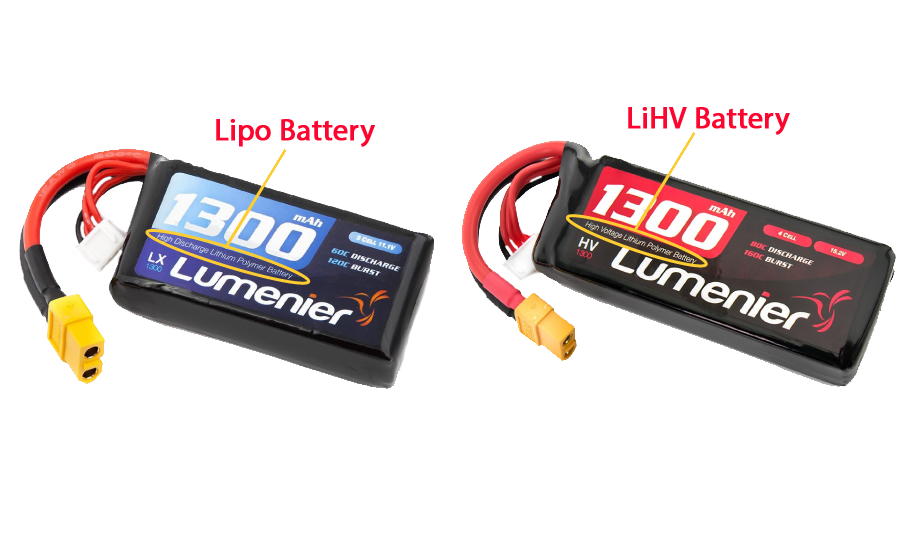
FPV Drone Battery Cells and Voltages:
Battery voltage is the potential energy difference between positive and negative terminals.
A higher FPV Drone Battery voltage allows you to power the quadcopter without increasing
the current or amp draw. A standard lithium polymer cell has a nominal (storage) voltage
or 3.7V, which means that the LiPO pack can be delivered together, these cells are grouped
together in series. positive lead of the next cell, forming a chain of individual cells) to increase
the overall battery pack voltage. LiPO packs are commonly sold in 1S, 2S, 3S, 4S, 5S or 6S
configurations where the digit is followed by the 'S' stands for number of cells in
that specific pack. The more cells that are grouped together, the more voltage the battery
pack will have. The battery pack voltage is important as it impacts the maximum motor
speed of a quadcopter. This is explained further here [inserts hyperlink to the article on
motors / section on KV] but simply, more battery voltage allows the motors to spin with
greater speed (RPM). For this reason, 4S LiPOs are the most commonly used for racing
quadcopters as they provide a balance between speed and weight. The following table
summarizes the voltage and common applications for various LiPO cell configurations.
It is important to note that the quadcopter applications listed in the following table are
different battery-quadcopter combinations in existence. Exotic setups such as 5S
150mm racing quadcopters or 2S micro brushed quadcopters do exist however they
are just quite uncommon.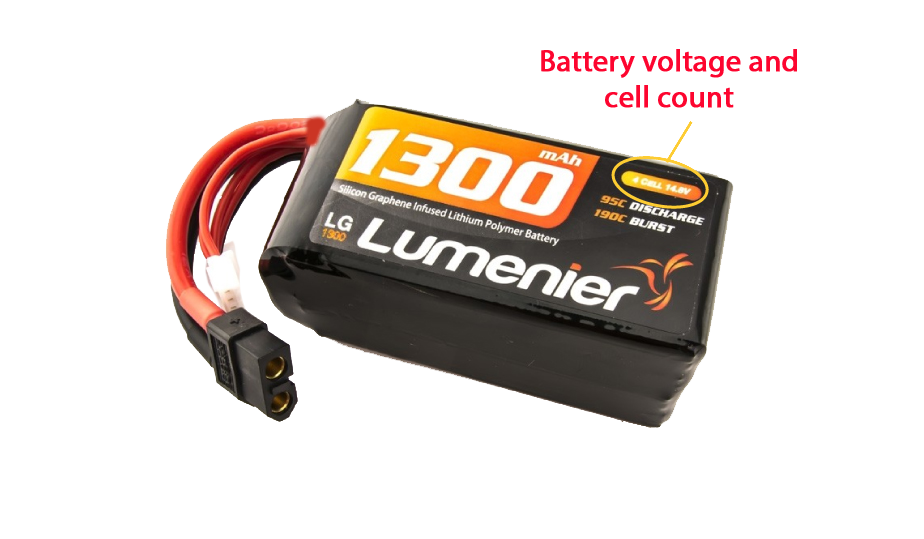
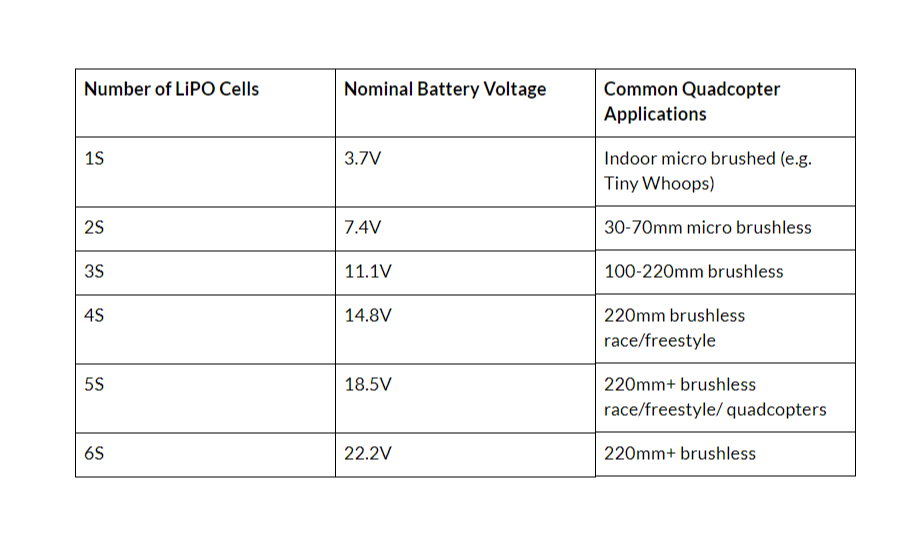
FPV Drone Battery C-Rating:
Battery capacity is measured in milliamp hours (mAh) which is a unit describing the
current capacity of a unit of time. As an example, a 1500mAh battery would be able to
supply: 1500 milliamps (1.5A) or current for an hour, 3000mA (3A) or current for a total
of 30 minutes, 6000 mA (6A) for 15 minutes and so on. A higher milliamp rating on
a battery means that it will provide more flight time per charge. When choosing a battery,
a sacrifice must be made between the battery size and the weight. A larger capacity
battery will provide a longer flight times however the added weight will reduce the performance
of the quadcopter by increasing the craft's momentum making it a more sluggish manner.
In racing scenarios, the usual selected battery capacities for a 220 sized quadcopter range
from 1000mAh to 1500mAh with 1300mAh packs being the most common. On average, a
1300mAh 4S pack will last for about three minutes in a racing quadcopter although flight time
is entirely dependent on the manner in which the craft is flown. A professional racing pilot can
easily discharge a 1300mAh 4S pack in under two minutes compared with a slower flying
beginner. When flying longer or faster circuits, many professional race pilots will actually
switch from a 1300mAh 4S pack to a heavier 1500mAh battery to reduce the need for
battery voltage management during a race. In order to achieve increased flight times
(5-8 minutes), long range quadcopter pilots will use even bigger batteries up
to 2200mAh as flight performance is or less regard to them than flight time.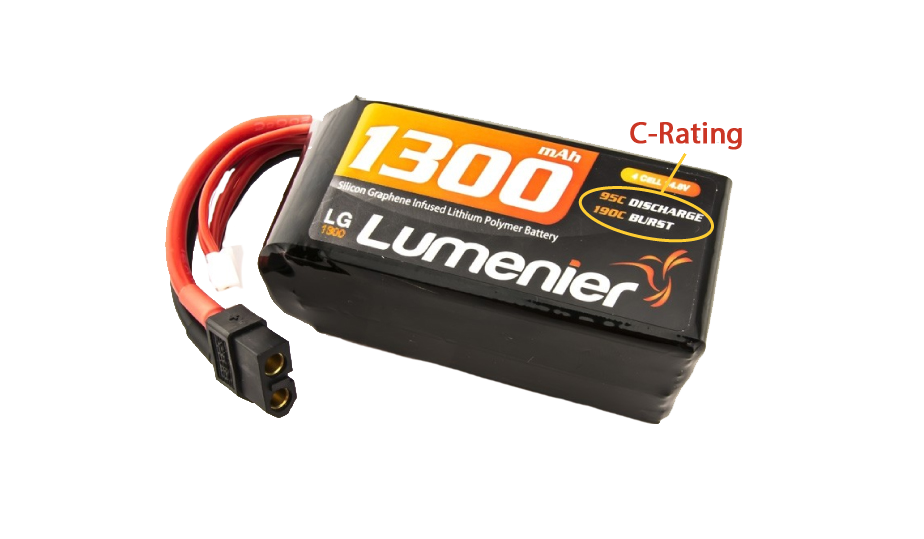
FPV Drone Battery Capacity:
The C-rating of a battery is a unit of measurement dictating how much battery can be
supplied. Simply put, the higher the C-rating of a battery. The C-Rating can be multiplied
by a battery capacity in order to calculate a pack of theoretical maximum discharge current.
Larger capacity batteries can also supply more current as their internal electrodes have
a greater surface area. For example, using the below C-Rating and milliamp conversion
formula, a 1800mAh 100C battery would be able to supply more than one 1300mAh 100C
battery (180,000mA / 180A maximum current versus 130,000mA / 130A maximum current
respectively). If a battery is forced to supply more than dictated by its C-Rating for a
significant period of time, it can cause a lot of damage, cause excess heating and
occasionally cause a LiPO fire. For this reason, it is important to use batteries with C-ratings
that are adequate for their application. For most 220 sized quadcopters, batteries with
C-ratings or 70C or higher are usually recommended, however, quadcopters using high
KV and / or large motors may require higher C-Rating batteries.
C-Rating Formula: Maximum Safe Current Draw (mA) = Battery Capacity (mAh) * C-Rating
Milliamp Hour Conversion Formula: 1000mA = 1A (one amp is one thousandth of a milliamp)
Another use for the C-Rating formula is to calculate the compatibility between different
motors, propellers, electronic speed controllers (ESCs) and batteries. As an example, a
1300mAh 100C battery would have a safe continuous current draw of 130A
(130,000mA). Dividing this number by four (as a quadcopter has four motors)
it is apparent that 32.5A is the maximum current draw per engine that this battery
can supply continuously. The maximum continuous current draw (in this case a
30-35 A ESC would be the most suitable). As a generalization, most batteries
have to be restored. This means that a motor-propeller combination is within
the calculated maximum continuous current draw per engine. It is safe to assume
that for most flights, the average throttle position will be a maximum of 75%.
Using this logic, a motor-propeller combination will, on average, be suitable for use
on a quadcopter if 75% of the maximum motor current draw is below the calculated
maximum continuous current draw per motor. Going back to the current example,
a motor-propeller combination quoted with a maximum current draw of 40A would
be suitable for use with the 1300mAh 100C battery as the average current would
be 30A (0.75 * 40A) which is below the calculated maximum continuous current
draw per motor or 32.5A. The website: https://www.miniquadtestbench.com/ is a
useful resource when performing these calculations as it provides data comparing the
maximum current draw and thrust for many different motor and propeller combinations.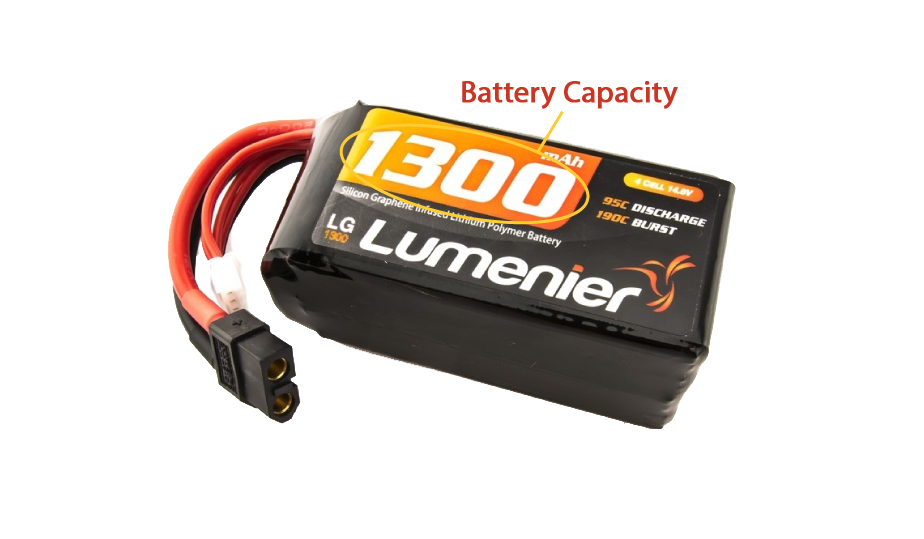
FPV Drone Battery Connectors:
There are a whole range of available LiPO battery connectors. The most common
connector is the yellow XT60 which is used on about 95% or 220mm sized quadcopters
running a 3S-6S LiPO FPV Drone Battery. Micro drones such as the Tiny Whoop commonly
used the JST-XH as it provides more JST-PH. The following table summarizes the most
commonly used battery connectors: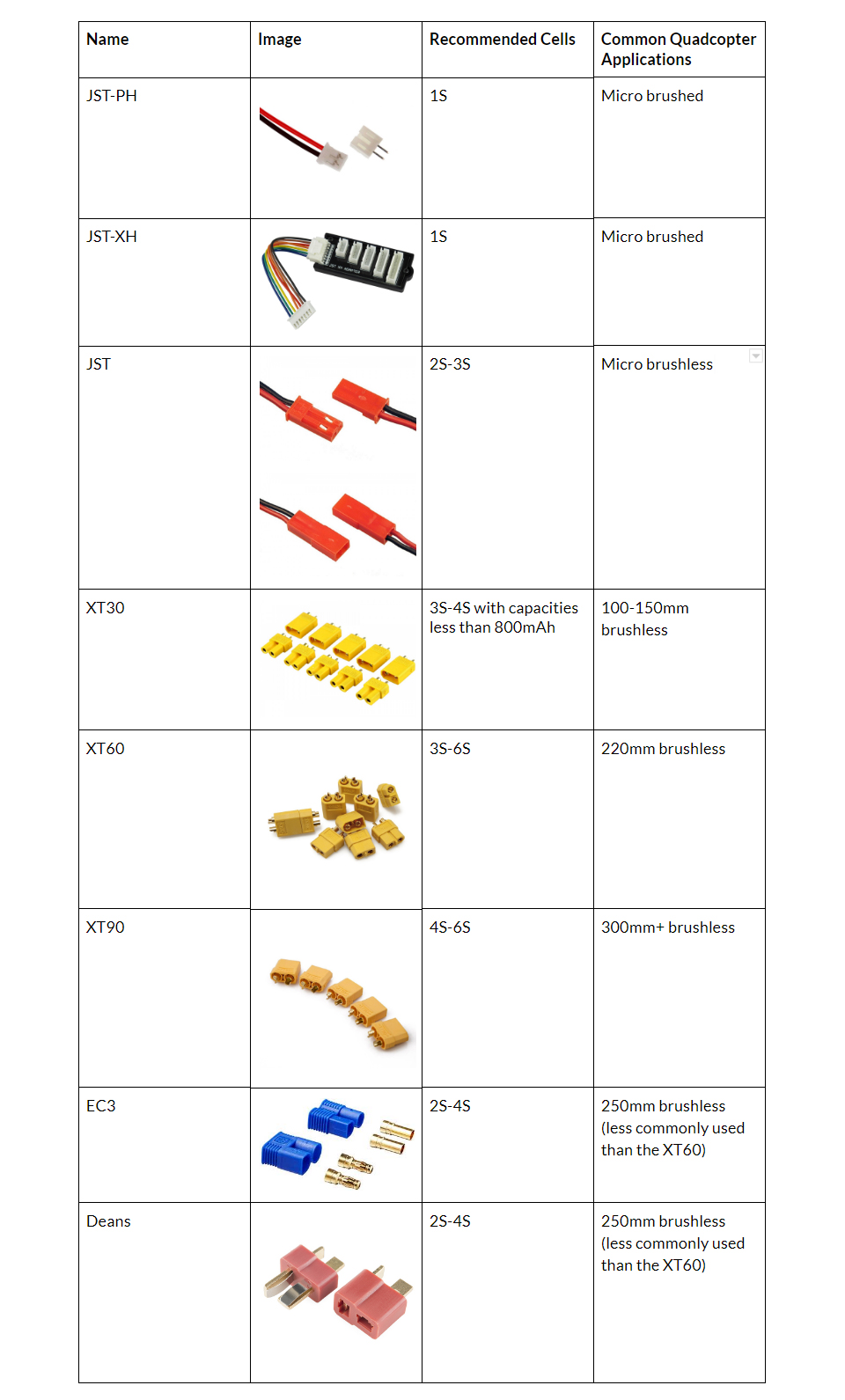
LiPO batteries (except in the case of a 1S) will also have a balance lead. This is a
standard JST-XH connector with 3-7 pin that is used to charge the battery pack.
More information on balance can be found here [insert hyperlink to charging / balance
charging article]. This connector has one positive pin for every cell in the battery pack
and a ground wire (usually black). A battery checker can be plugged into this connector
to monitor the voltage of each individual LiPO cell, simplifying the process of distinguishing
charged and discharged batteries.
LiPo Safety:
The danger of LiPO batteries is something that many people underestimate
but should not be overlooked. Lithium batteries store large quantities of energy
and are occasionally prone to catching fire. This is a rare scenario and is most
likely to occur when charging, discharging, or if a battery becomes damaged.
Regardless of the odds, a fire can result in houses burning down, self-injury or
damage to gear. For this reason, it is essential for all pilots to store and ideally
charge their quadcopters lithium batteries in a fire-proof LiPO bag or box. If you
have already spent a few hundred dollars on FPV gear, what is a few more to
potentially save a lot more in damage.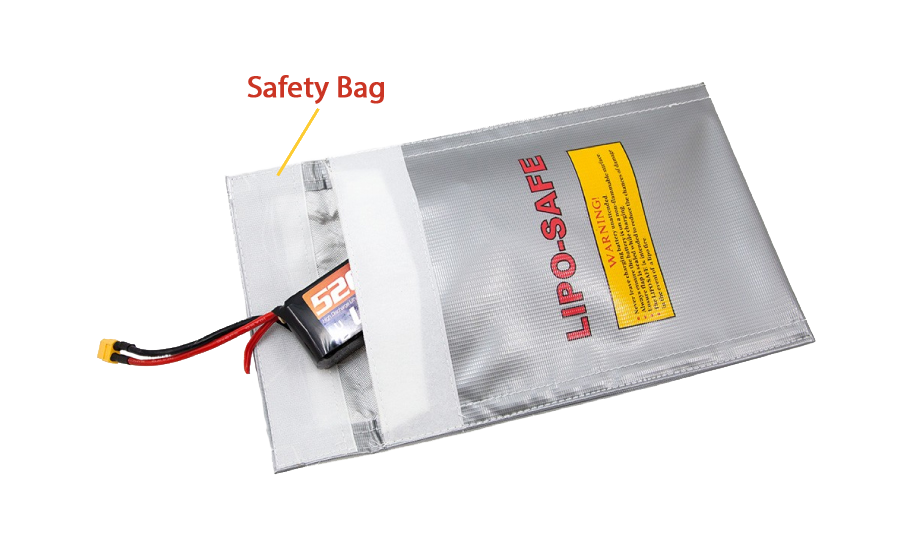
FPV Drone Battery Disposal:
LiPO batteries are disposable items with a limited lifespan or around 150-250
cycles (Battery University 2017) although this number is entirely dependent on the
manner in which they are used. The main factors are the longevity of a LiPO are
over-discharging and leaving packs in a charged / discharged state for long periods
of time. To increase the longevity of a LiPO, it is recommended to store LiPe batteries
at 3.8V per cell and to land a quadcopter at a minimum of around 3.5V per cell
(although landing at 3.65V per cell is the safest option). When the LiPO is
nearing the end of life cycle, large voltage drops will be noticeable on throttle
punches as the quad will fail to speed up the motors. The LiPO will also lose an
increasing percentage of its capacity meaning reduced flight times. To properly
dispose of a LiPO, the safest option is to use a battery charger to connect the
power leads to a 12V incandescent light bulb for several hours. This will ensure that
the LiPO is fully discharged to 0V. As entertaining as the fireball looks, it is not wise to
dispose of a LiPO by puncturing or damaging it. Once the LiPO has been discharged
completely, it is ideal to cover over the battery terminals and take the battery
recycling facility in order to reduce the overall environmental impact (Battery University 2017).
Who Plugged In?
On a final note, when at a race meet or flying with other pilots, it is common FPV
etiquette to leave your quadcopter with other pilots are in the air. This prevents a
scenario where a pilot is blasted out of the air by your video transmitter powering up
and makes the event run a lot more smoothly.
